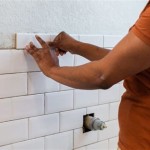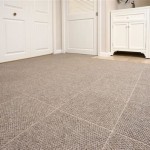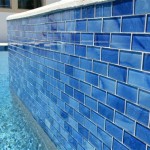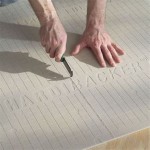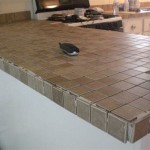How To Clean Dirty Grout Between Floor Tiles
Grout, the porous material filling the spaces between tiles, is notorious for accumulating dirt, grime, and stains. Its recessed position and textured surface make it a magnet for spills, tracked-in mud, and general household debris. Neglecting grout cleaning can lead to discoloration, mold growth, and a significant reduction in the overall aesthetic appeal of tiled surfaces. Maintaining clean grout requires a systematic approach and the use of appropriate cleaning agents and tools. This article details various methods for effectively cleaning dirty grout between floor tiles, providing a comprehensive guide for achieving a clean and revitalized tiled floor.
Understanding Grout Composition and Soiling
To effectively clean grout, it is crucial to understand its composition and the types of soiling it typically encounters. Grout is primarily composed of cement, sand, and water, often with added polymers for flexibility and durability. Its porous nature allows liquids and particles to penetrate, leading to staining and discoloration. Common types of soiling include:
Dirt and Grime:
This is the most prevalent type of soiling, resulting from tracked-in dirt, dust, and general household debris. Regular foot traffic exacerbates the problem, pushing particles deeper into the grout pores.
Spills and Splatters:
Food and beverage spills, particularly those containing pigments or dyes (e.g., coffee, juice, wine), can cause significant staining if not addressed promptly.
Mold and Mildew:
In damp environments like bathrooms and kitchens, mold and mildew can thrive on grout surfaces. These organisms not only discolor the grout but also pose potential health risks. Their presence is often indicated by dark, blotchy stains.
Hard Water Deposits:
In areas with hard water, mineral deposits can accumulate on grout, leaving a chalky white residue that is difficult to remove.Understanding the nature of the soiling helps in selecting the most appropriate cleaning method and cleaning agents for optimal results.
Methods for Cleaning Dirty Grout
Several methods can be employed to clean dirty grout, ranging from simple household solutions to more specialized cleaning products and tools. The choice of method depends on the severity of the soiling, the type of grout, and personal preferences.
1. Hot Water and Scrub Brush:
For light soiling, hot water and a stiff-bristled scrub brush can be surprisingly effective. The hot water helps to loosen dirt and grime, while the brush provides the necessary agitation to lift the particles from the grout pores. This method is environmentally friendly and suitable for regular maintenance cleaning. Furthermore, using this process first prevents the need for more aggressive chemicals. If this method works well, the subsequent steps can be skipped.
Procedure:
a. Heat water to a near-boiling temperature (ensure it is safe for the type of tile and grout used).
b. Apply the hot water directly to the grout lines.
c. Allow the water to sit for a few minutes to loosen the dirt.
d. Scrub the grout lines vigorously with a stiff-bristled brush (a grout brush is ideal).
e. Rinse the area thoroughly with clean water.
f. Dry the area with a clean cloth to prevent water spots.
2. Baking Soda Paste:
Baking soda is a mild abrasive and a natural deodorizer, making it an excellent option for cleaning grout. It is also safe for use on most types of tile and grout. For more stubborn stains, it can be mixed with other ingredients.
Procedure:
a. Mix baking soda with water to form a thick paste.
b. Apply the paste to the grout lines.
c. Allow the paste to sit for 10-15 minutes.
d. Scrub the grout lines with a stiff-bristled brush.
e. Rinse the area thoroughly with clean water.
f. Dry the area with a clean cloth.
3. Vinegar Solution:
Vinegar is a natural acid that can effectively dissolve dirt, grime, and hard water deposits. However, it is important to note that vinegar should be used with caution on certain types of stone tiles, as it can etch the surface. Test the solution on an inconspicuous area before applying it to the entire tiled surface.
Procedure:
a. Mix equal parts white vinegar and water in a spray bottle.
b. Spray the solution onto the grout lines.
c. Allow the solution to sit for 5-10 minutes.
d. Scrub the grout lines with a stiff-bristled brush.
e. Rinse the area thoroughly with clean water.
f. Dry the area with a clean cloth.
4. Baking Soda and Vinegar Combination:
Combining baking soda and vinegar creates a fizzing action that can help loosen stubborn dirt and stains. This method should be used with caution due to the potential for releasing carbon dioxide, which can be irritating in poorly ventilated areas.
Procedure:
a. Sprinkle baking soda onto the grout lines.
b. Spray vinegar onto the baking soda.
c. Allow the mixture to fizz for a few minutes.
d. Scrub the grout lines with a stiff-bristled brush.
e. Rinse the area thoroughly with clean water.
f. Dry the area with a clean cloth.
5. Hydrogen Peroxide:
Hydrogen peroxide is a mild bleaching agent that can effectively remove stains and kill mold and mildew. It is generally safe to use on grout and tile, but it is advisable to test it on an inconspicuous area first.
Procedure:
a. Pour hydrogen peroxide (3% solution) directly onto the grout lines.
b. Allow it to sit for 10-15 minutes.
c. Scrub the grout lines with a stiff-bristled brush.
d. Rinse the area thoroughly with clean water.
e. Dry the area with a clean cloth.
6. Commercial Grout Cleaners:
Numerous commercial grout cleaners are available, ranging from general-purpose cleaners to specialized products for removing specific types of stains or mold. When using commercial cleaners, it is crucial to follow the manufacturer's instructions carefully and to wear appropriate personal protective equipment, such as gloves and eye protection. In particular, pay attention to the required ventilation during use.
Procedure:
a. Apply the grout cleaner according to the manufacturer's instructions.
b. Allow the cleaner to sit for the recommended time.
c. Scrub the grout lines with a stiff-bristled brush.
d. Rinse the area thoroughly with clean water.
e. Dry the area with a clean cloth.
7. Steam Cleaning:
Steam cleaners use hot steam to loosen dirt and grime from grout. This method is effective for cleaning grout without the use of harsh chemicals. Ensure the steam cleaner is appropriate for the type of tile and grout. In addition, ensure proper ventilation is available during application.
Procedure:
a. Fill the steam cleaner with water according to the manufacturer's instructions.
b. Attach the grout cleaning nozzle to the steam cleaner.
c. Direct the steam at the grout lines, moving slowly along each line.
d. Wipe away the loosened dirt and grime with a clean cloth.
e. Allow the area to dry completely.
Tools for Cleaning Grout
The effectiveness of any grout cleaning method is enhanced by using the right tools. Key tools for cleaning grout include:
Grout Brush:
A specialized brush with stiff, angled bristles designed to fit into grout lines. It provides the necessary scrubbing power to remove dirt and grime.Stiff-Bristled Scrub Brush:
A general-purpose scrub brush with stiff bristles can also be used to clean grout, although it may not be as effective as a grout brush for reaching into narrow grout lines.Spray Bottle:
Useful for applying cleaning solutions evenly onto the grout lines.Sponge:
For wiping away excess cleaning solution and rinsing the area.Clean Cloths:
For drying the area after cleaning.Protective Gloves:
To protect hands from harsh chemicals and abrasion.Eye Protection:
To prevent cleaning solutions from splashing into the eyes.In addition to these basic tools, a small vacuum cleaner with a crevice tool can be used to remove loose debris before cleaning. Also, a magic eraser can be used to remove stubborn stains after using one the methods stated above.
Preventing Grout from Getting Dirty
Preventing grout from getting dirty in the first place is the best way to minimize the need for extensive cleaning. Several preventative measures can be taken to keep grout clean and maintain its appearance:
Regular Cleaning:
Wipe up spills and stains immediately to prevent them from penetrating the grout pores. Sweep or vacuum tiled floors regularly to remove loose dirt and debris.Grout Sealing:
Applying a grout sealant creates a protective barrier that prevents liquids and stains from penetrating the grout. Grout should be sealed periodically, typically every 1-2 years, depending on the type of sealant and the level of traffic. Ensure newly installed grout is properly sealed after installation.Entrance Mats:
Placing entrance mats at doorways helps to trap dirt and debris before they are tracked onto tiled floors.Ventilation:
Ensure adequate ventilation in bathrooms and kitchens to prevent the growth of mold and mildew. Use exhaust fans during and after showering or cooking. Minimize humidity in areas with tile floors.Avoid Abrasive Cleaners:
While abrasive cleaners can remove dirt, they can also damage the grout and tile surfaces over time. Avoid using harsh scouring powders or abrasive pads.Proper Footwear:
Encourage the use of slippers or indoor shoes to reduce the amount of dirt and debris tracked onto tiled floors.By implementing these preventative measures, the frequency and intensity of grout cleaning can be significantly reduced, preserving the appearance and integrity of tiled surfaces.

How To Clean Grout Tile Cleaning Tips Simply Spotless

How To Clean Grout Tips For Natural Stone Flooring Granite Gold

How To Clean Grout Between Floor Tiles Easy Stain Removal

How To Clean Grout Between Floor Tiles

How To Clean Floor Tile Grout Without Scrubbing Easy Guide

How To Clean Grout Between Floor Tiles Ultimate Guide Ceramic City Wall And

How To Clean Grout Two Ingredient Diy Cleaner Lemons Lavender Laundry

How To Clean Grout Between Floor Tiles Easy Stain Removal

How To Effectively Clean Grout In Tile Flooring Guide

7 Proven Ways To Clean Shower Tile Works Every Time
Related Posts

